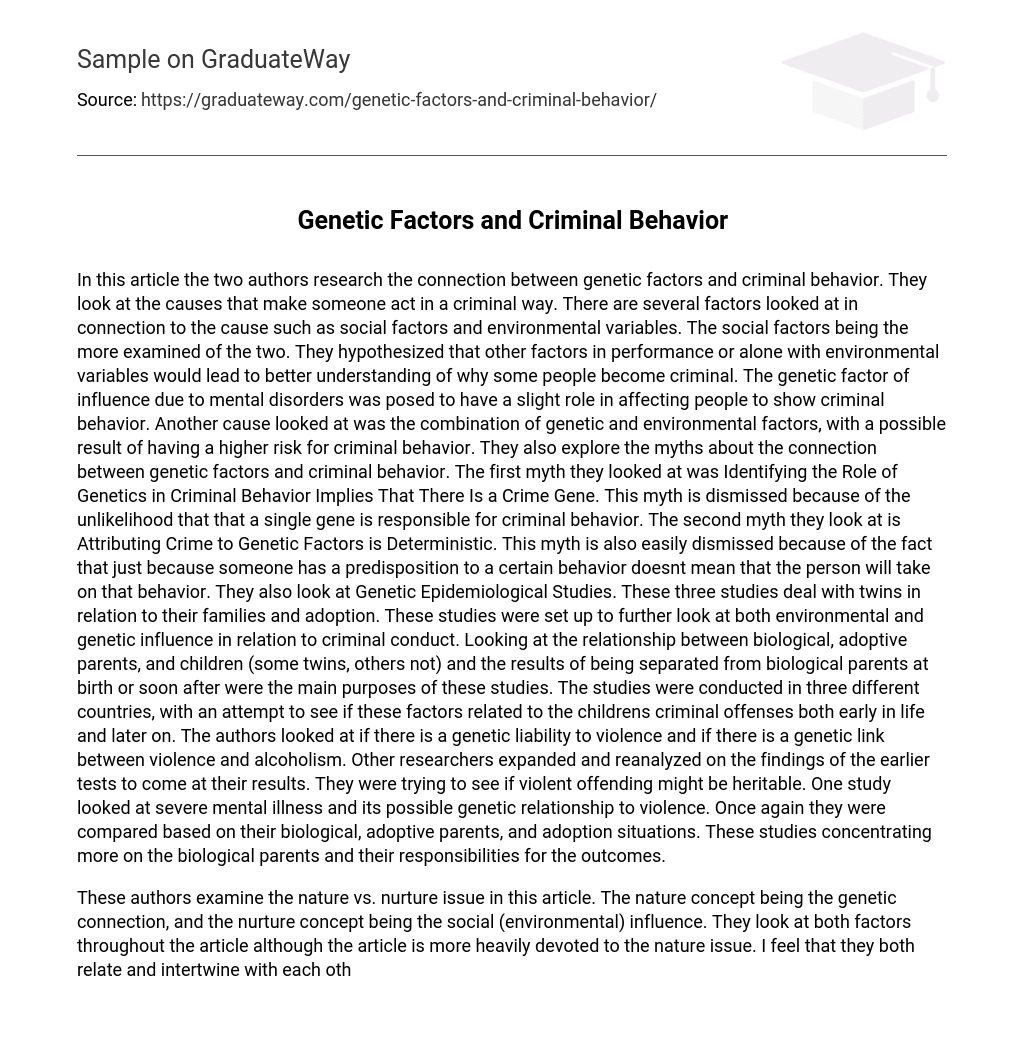In this article the two authors research the connection between genetic factors and criminal behavior. They look at the causes that make someone act in a criminal way. There are several factors looked at in connection to the cause such as social factors and environmental variables. The social factors being the more examined of the two. They hypothesized that other factors in performance or alone with environmental variables would lead to better understanding of why some people become criminal. The genetic factor of influence due to mental disorders was posed to have a slight role in affecting people to show criminal behavior. Another cause looked at was the combination of genetic and environmental factors, with a possible result of having a higher risk for criminal behavior. They also explore the myths about the connection between genetic factors and criminal behavior.
The first myth they looked at was Identifying the Role of Genetics in Criminal Behavior Implies That There Is a Crime Gene. This myth is dismissed because of the unlikelihood that that a single gene is responsible for criminal behavior. The second myth they look at is Attributing Crime to Genetic Factors is Deterministic. This myth is also easily dismissed because of the fact that just because someone has a predisposition to a certain behavior doesnt mean that the person will take on that behavior. They also look at Genetic Epidemiological Studies. These three studies deal with twins in relation to their families and adoption. These studies were set up to further look at both environmental and genetic influence in relation to criminal conduct. Looking at the relationship between biological, adoptive parents, and children (some twins, others not) and the results of being separated from biological parents at birth or soon after were the main purposes of these studies. The studies were conducted in three different countries, with an attempt to see if these factors related to the childrens criminal offenses both early in life and later on.
The authors looked at if there is a genetic liability to violence and if there is a genetic link between violence and alcoholism. Other researchers expanded and reanalyzed on the findings of the earlier tests to come at their results. They were trying to see if violent offending might be heritable. One study looked at severe mental illness and its possible genetic relationship to violence. Once again they were compared based on their biological, adoptive parents, and adoption situations. These studies concentrating more on the biological parents and their responsibilities for the outcomes.
These authors examine the nature vs. nurture issue in this article. The nature concept being the genetic connection, and the nurture concept being the social (environmental) influence. They look at both factors throughout the article although the article is more heavily devoted to the nature issue. I feel that they both relate and intertwine with each other. I feel that alone your genetic makeup is not going to make you more likely to commit a crime. Just as your social influence alone is not going to make you more likely to commit a crime. I feel that the two factors have to work together if you will to show a significant amount of criminal behavior. In other words I feel that nature and nurture are both factors to be considered side-by-side and not as separate issues as they are so often viewed.
The authors concluded that yes genetics are one source of influence on criminal behavior, and by excluding them we could be causing delays in advancement of understanding, prevention, intervention, and even treatment. They also concluded that either social or genetic factors could help identify people who are at a higher risk for awful outcomes. Their final conclusion stated, the genetic vulnerability maybe counterbalanced by positive environmental conditions. There have even been two studies that have supported their conclusion that crime prevention will be most profitable when both social and genetic factors are looked at. Its clear that there is still more research to be done, but from the studies we have yet to date it is clear that the results are telling us that looking at the two factors together will have a greater outcome in the future.





